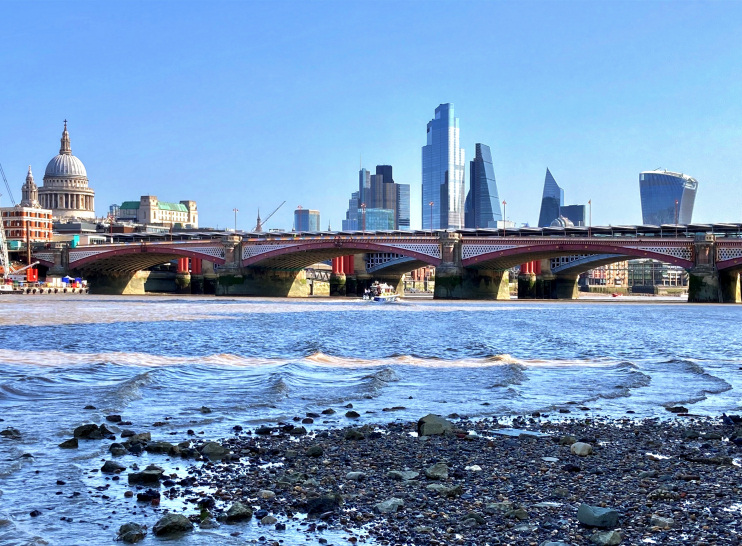City of London
City of London, City of London
The City with a capital ‘C’ always refers to the City of London, either in the literal geographical sense or as a figurative term for London’s financial centre

The City extends from Chancery Lane in the west to Mansell Street and Middlesex Street (Petticoat Lane) in the east. It is bounded by the Thames to the south and its jagged northern border reaches its farthest point just short of the western end of Old Street.
The Romans appear to have decided to make Londinium their capital soon after invading Britain in 43AD and built a defensive wall that encompassed 330 acres on its completion in the third century. With the departure of the Romans early in the fifth century, the Saxons established their main trading settlement in the vicinity of the Aldwych and the City fell into decline.
The construction of the first St Paul’s Cathedral in 604 was the first sign of renewed growth and by the ninth century prosperity had returned, with Cheapside becoming London’s high street.
Although the Normans made Westminster their seat of government, William the Conqueror built a castle that later became the Tower of London at the south-east corner of the City. (The Tower nowadays finds itself just outside the City of London boundary: it is in the London Borough of Tower Hamlets.)
Richard I allowed Londoners to choose their own mayor and the Guildhall was constructed in the early 15th century as a form of parliament for representatives from the City’s merchant guilds.
The establishment of the Royal Exchange in 1570 consolidated London’s role as a leading international trading centre, but like most of the City’s buildings it burned down in the Great Fire of London in 1666. The medieval street plan was retained in the City’s reconstruction, but brick and stone were used for the replacement buildings, rather than wood. Sir Christopher Wren was commissioned to rebuild the City’s churches, including St Paul’s Cathedral.
The Bank of England was founded in 1694 and evolved into the official custodian of the nation’s currency over the course of the following century. Other great financial institutions also assumed their modern form during this period, including the insurance brokers Lloyd’s of London and the main clearing banks. The Mansion House, the official residence of the Lord Mayor of London, was completed in 1752.
Britain was relatively unaffected by the wars that blighted Europe for more than two decades from 1792, allowing London to assume an unrivalled position as the mercantile centre of a growing empire. However, with more than 100,000 inhabitants crammed into the square mile, the vast majority of Londoners reaped scant reward from the City’s wealth and the reality of daily life was dark, dirty and noisome in the warrens of tenements in the poorer quarters.
A great change came with the building of the railways in the mid-19th century. Together with other improvements in transport and increasingly affordable fares, the railways stimulated a suburban building boom that allowed an exodus of residents.
The destruction wreaked in the Second World War resulted in the clearance of the most of the surviving dwellings and workshops, although the subsequent construction of the Barbican brought the return of a residential and cultural aspect.
From the late 1980s the regeneration of Docklands posed the most serious threat to the City’s vitality since the Romans left. The Corporation of London reacted by relaxing some of its strict planning controls, improving streetscapes and embarking on a worldwide promotional drive. Despite the loss of some major corporations, construction of new floorspace recovered – most visibly in the form of 30 St Mary Axe, better known as the Gherkin – and the City’s daytime population remains massive (at least in normal times); more than a quarter of a million people commuted here every day in 2019.
Boundary changes in 1994 increased the City’s area to 779 acres and added more than 30 per cent to its population – mainly from the Golden Lane and Mansell Street housing estates.
The City experienced a surge in the creation of residential units in the late 1990s, rising from almost none in 1994 to nearly 500 in 1999, split almost equally between new buildings and office-to-flat conversions. In the early years of the 21st century the craze faded, especially for conversions. However, the construction of office towers continued apace, interrupted only briefly by the financial crisis of 2007–8. The towers are mostly concentrated along and around Bishopsgate. The tallest of these is the recently completed 22 Bishopsgate. Farther south (on the far right in the photo above), the 38-storey ‘Walkie-Talkie’ (20 Fenchurch Street) has a publicly accessible viewing area, the Sky Garden.
The City of London Corporation’s planning and transport committee has granted approval for yet another tower, a 73-storey skyscraper formally called 1 Undershaft and nicknamed the Trellis, which will be second tallest building in western Europe after the Shard – if it gets built. Like the Walkie Talkie, it will include a free public viewing gallery.
Following the covid-19 pandemic, it seems almost certain that construction of new skyscrapers will cease for a while, as developers assess the consequences of the shift to working from home, which is likely to become permanent for a proportion of office workers, at least for two or three days a week. It’s possible that the City of London will never again be quite the same place as it was before 2020.
The City’s demographic profile is radically different from that of any other local authority in London. Sixty per cent of residents are qualified to degree level or higher and a similar proportion of households have only one occupant. The proportion of residents aged under 19 is less than half the national average.
